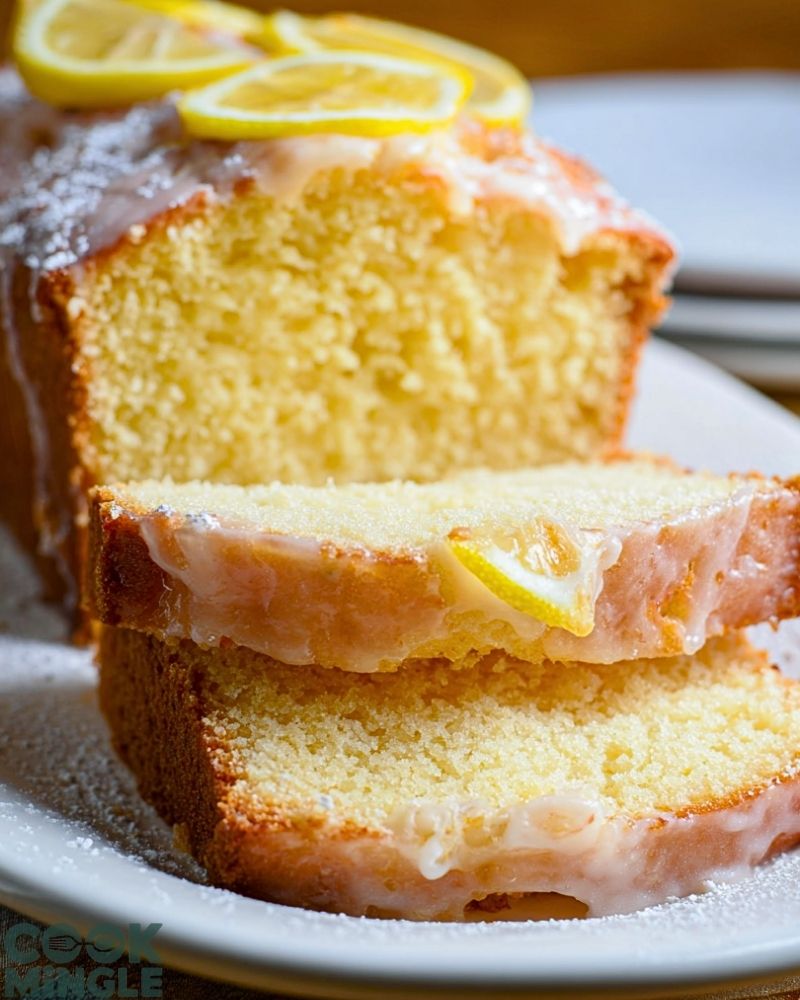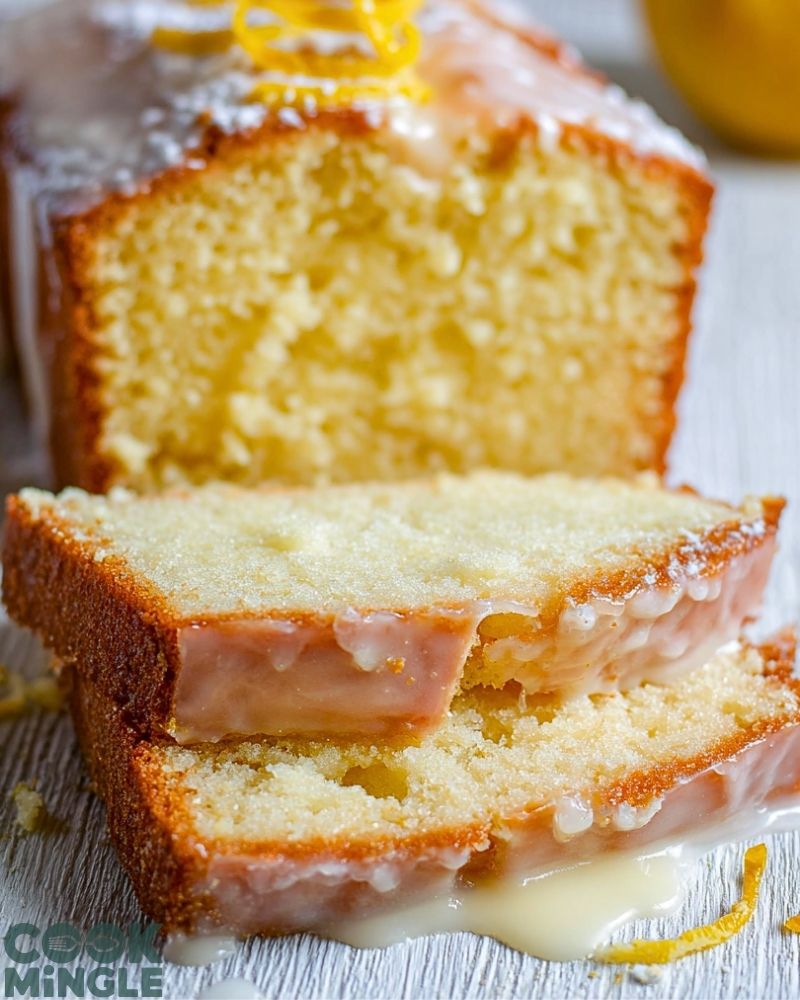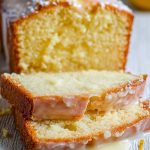This Lemon Pound Cake is the perfect balance of rich, buttery indulgence and zesty citrus brightness. Each bite offers a moist, dense crumb infused with fresh lemon juice and zest, then topped with a simple lemon glaze that crackles lightly over the top. The aroma alone as it bakes will draw everyone into the kitchen, and once served, it disappears fast!

It’s a cake that feels both nostalgic and elegant, equally suited for an afternoon tea, a brunch table centerpiece, or as a sunny pick-me-up dessert. The slices are satisfying and sturdy, yet melt-in-your-mouth soft, delivering a clean lemon flavor that lingers without overwhelming. It’s the kind of cake you keep coming back to.
Why You’ll Love This Lemon Pound Cake
- Bright, fresh flavor: The real lemon zest and juice make it naturally vibrant without being overly sweet.
- Moist texture: Thanks to the balance of butter, eggs, and sour cream, this pound cake stays tender and never dry.
- Simple ingredients: Everything you need is likely already in your pantry.
- Perfect for any occasion: Dress it up for special events or enjoy a casual slice with tea.
- Make-ahead friendly: It stores beautifully, making it great for gifting or planning ahead.
Preparation Phase & Tools to Use (Essential Tools and Their Importance)
Creating the perfect Lemon Pound Cake starts with being well-prepared. Setting up your tools and workspace before mixing ingredients ensures smooth progress and helps avoid overmixing or missteps.
Essential Tools:
- Stand Mixer or Hand Mixer: Vital for creaming the butter and sugar properly—this is key to the cake’s light yet rich texture.
- Bundt Pan or Loaf Pan: A Bundt pan gives that classic look and even bake, while loaf pans work just as well for a simpler shape.
- Microplane Zester: Extracts lemon zest finely without the bitter white pith, packing in maximum citrus aroma.
- Citrus Juicer: Ensures you get every drop of juice with minimal seeds or mess.
- Measuring Cups & Kitchen Scale: Accurate measurements are crucial, especially for a dense, balance-sensitive bake like pound cake.
- Rubber Spatula: Helps fold and scrape batter efficiently, avoiding waste and ensuring even mixing.
- Cooling Rack: Prevents soggy bottoms by allowing air circulation once the cake is out of the oven.
Preparation Tips
- Bring ingredients to room temperature: This includes butter, eggs, and sour cream. It helps the batter blend evenly and traps more air during mixing.
- Grease your pan thoroughly: Use softened butter and a dusting of flour or baking spray to prevent sticking—especially important with intricate Bundt pans.
- Don’t overmix the batter: After adding the flour, mix only until just combined. Overmixing can result in a dense or rubbery texture.
- Use fresh lemons: Bottled juice won’t have the same brightness and can taste flat.
- Preheat your oven: Pound cakes need even, steady heat from the start to rise and bake evenly.
Ingredients for This Lemon Pound Cake
To make this bright and buttery Lemon Pound Cake, you’ll need the following ingredients. Each one plays an important role in flavor, texture, or structure:
For the Cake:
- 1 cup (226g) unsalted butter, softened – Adds richness and moisture
- 2 cups (400g) granulated sugar – Sweetens and helps cream the butter to create a light texture
- 4 large eggs, room temperature – Binds the batter and gives the cake structure
- 2 tablespoons lemon zest – Provides intense lemon fragrance and flavor
- 1/4 cup fresh lemon juice – Enhances the lemon taste with a tangy kick
- 2 1/2 cups (310g) all-purpose flour – The base of the cake, gives it body
- 1/2 teaspoon baking powder – Offers slight lift to balance the cake’s density
- 1/2 teaspoon salt – Balances sweetness and enhances flavor
- 1/2 cup sour cream – Keeps the cake incredibly moist and tender
- 1 teaspoon vanilla extract – Adds depth and rounds out the citrus notes
For the Lemon Glaze:
- 1 cup powdered sugar – The base of the glaze
- 2–3 tablespoons fresh lemon juice – To thin and flavor the glaze
- Optional: Lemon slices, for garnish – A beautiful, simple decoration

Step 1: Prep the Oven and Pan
Preheat your oven to 325°F (163°C). Generously grease a Bundt or loaf pan with butter and lightly dust with flour, or use a baking spray. Tap out any excess flour. This ensures your cake releases cleanly after baking.
Step 2: Cream Butter and Sugar
In a large mixing bowl, cream the softened butter and granulated sugar together on medium-high speed for 4–5 minutes, until light and fluffy. This step is crucial—it builds air into the batter, helping create a soft, velvety crumb.
Step 3: Add Eggs One at a Time
Beat in the eggs, one at a time, making sure each egg is fully incorporated before adding the next. Scrape down the sides of the bowl between additions to ensure an even mix.
Step 4: Add Lemon and Vanilla
Mix in the lemon zest, lemon juice, and vanilla extract. The batter might look slightly curdled at this point, but that’s normal—it will smooth out once the dry ingredients are added.
Step 5: Combine Dry Ingredients
In a separate bowl, whisk together the flour, baking powder, and salt. Gradually add the dry mixture to the wet ingredients, mixing on low speed just until combined.
Step 6: Fold in Sour Cream
Using a rubber spatula, gently fold in the sour cream until no white streaks remain. This final touch gives the cake a moist, dense texture.
Step 7: Bake
Pour the batter into your prepared pan, smoothing the top. Bake for 55–65 minutes, or until a toothpick inserted into the center comes out clean or with just a few moist crumbs.
Step 8: Cool and Glaze
Let the cake cool in the pan for 10–15 minutes, then carefully invert it onto a cooling rack. Once completely cool, whisk together the powdered sugar and lemon juice to make a glaze. Drizzle over the cake and top with lemon slices, if using.
Notes
- Bundt vs. Loaf: You can use either a Bundt pan for a decorative shape or two loaf pans for a more classic presentation. Just adjust the baking time accordingly—loaves may bake slightly faster.
- Make it more lemony: Add a teaspoon of lemon extract to the batter if you want an extra punch of citrus.
- For a thicker glaze: Use less lemon juice, or add more powdered sugar until you reach the desired consistency.
- Glaze while warm or cool: Drizzling the glaze over a warm cake lets it soak in slightly, while glazing a cooled cake creates a crisp outer shell.
Watch Out for These Mistakes While Cooking
- Skipping room temperature ingredients: Cold butter or eggs can cause the batter to curdle or not mix evenly, affecting the texture.
- Overmixing after adding flour: Stirring too much activates gluten, which can make your pound cake tough.
- Under-greasing the pan: This can cause the cake to stick, especially in intricate Bundt molds. Always grease and flour well.
- Baking at too high a temperature: This leads to uneven rising and possibly a cracked top. Stick to 325°F for a gentle, even bake.
- Opening the oven door too early: Doing so can cause the center to collapse. Wait until at least the 50-minute mark to check.
- Not letting the cake cool in the pan: Removing it too soon may cause it to break apart; wait 10–15 minutes before inverting.
- Using bottled lemon juice: Fresh lemons provide better flavor and acidity—don’t settle for less.
- Overbaking: Always check early. A dry pound cake is hard to rescue, so aim for a clean or slightly moist crumb on the tester.
What to Serve With Lemon Pound Cake?
This Lemon Pound Cake is versatile and pairs well with both sweet and refreshing sides. Whether you’re planning a brunch, tea gathering, or a casual dessert spread, these ideas will elevate your presentation and delight guests.
8 Recommendations
1. Fresh Berries
Serve with a mix of raspberries, strawberries, or blueberries. Their tartness beautifully complements the lemony richness.
2. Whipped Cream
A soft cloud of lightly sweetened whipped cream adds a creamy contrast to the dense cake texture.
3. Vanilla Ice Cream
The warm-cold pairing is a classic, and vanilla lets the lemon flavor shine.
4. Lemon Curd
For the lemon lovers, a spoonful of curd on the side or lightly spread over the top intensifies the citrus experience.
5. Mint Sprigs
Just a few leaves can refresh the palate and add a pop of green on your plate.
6. Hot Tea or Earl Grey
The citrus notes in Earl Grey pair especially well with the cake, making it ideal for an afternoon tea.
7. Iced Coffee or Cold Brew
The bitterness of coffee balances the sweetness of the glaze and sugar in the cake.
8. Greek Yogurt and Honey
For a more brunch-style serving, try it with a scoop of plain Greek yogurt drizzled with honey—fresh and satisfying.
Storage Instructions
To keep your Lemon Pound Cake fresh and flavorful:
- Room Temperature: Store the cake in an airtight container or wrapped in plastic wrap at room temperature for up to 3 days. Keep it in a cool, dry place away from direct sunlight.
- Refrigerator: For longer storage, refrigerate it tightly wrapped for up to 7 days. Let it come to room temperature before serving for best texture.
- Freezer: This cake freezes beautifully. Wrap individual slices or the entire cake in plastic wrap, then foil, and freeze for up to 3 months. Thaw overnight in the fridge or at room temp before eating.
Tip: Avoid freezing the glaze—if possible, freeze the cake unglazed and drizzle fresh glaze once thawed.
Estimated Nutrition
Per serving (based on 12 slices):
- Calories: 380
- Total Fat: 19g
- Saturated Fat: 11g
- Cholesterol: 95mg
- Sodium: 160mg
- Carbohydrates: 48g
- Sugar: 31g
- Protein: 4g
- Fiber: 0.5g
Note: Nutrition values may vary depending on the brand of ingredients used and any substitutions.
Frequently Asked Questions
1. Can I use bottled lemon juice instead of fresh?
Fresh lemon juice is highly recommended for the best flavor. Bottled versions often have preservatives that dull the taste.
2. Can I make this cake ahead of time?
Absolutely. The cake keeps well for several days and actually tastes even better the next day after the flavors have settled.
3. What if I don’t have a Bundt pan?
You can bake it in two standard loaf pans. Start checking for doneness at 50 minutes since loaf pans bake faster.
4. How do I keep the cake from sticking to the pan?
Use softened butter and flour or a baking spray with flour. Make sure to coat every crevice, especially in a Bundt pan.
5. Can I make this gluten-free?
Yes, use a 1:1 gluten-free flour blend. Be sure it includes xanthan gum for structure.
6. Why did my cake sink in the middle?
Possible reasons include underbaking, opening the oven door too early, or too much leavening. Always test with a toothpick before removing.
7. Can I skip the glaze?
You can, but the glaze adds a bright finish. If you prefer less sugar, drizzle lightly or use a lemon syrup instead.
8. What’s the best way to zest a lemon?
Use a microplane zester and avoid the white pith underneath, which is bitter.
Conclusion
This Lemon Pound Cake is a beautiful balance of tangy, sweet, and buttery flavors wrapped in a soft, moist crumb. It’s simple enough for weekday baking but elegant enough for celebrations. Whether you enjoy it warm with tea or chilled with berries, it delivers a comforting, sun-kissed taste in every slice. With the right tools and tips, it’s a foolproof classic you’ll want to make again and again.

Lemon Pound Cake
- Total Time: 1 hour 15 minutes
- Yield: 12 servings
Description
This Lemon Pound Cake is a moist, buttery delight infused with real lemon zest and juice for a bright, tangy flavor. It’s topped with a simple lemon glaze that adds a sweet finish and makes it perfect for any occasion—from afternoon tea to festive brunches.
Ingredients
For the Cake:
- 1 cup (226g) unsalted butter, softened
- 2 cups (400g) granulated sugar
- 4 large eggs, room temperature
- 2 tablespoons lemon zest
- 1/4 cup fresh lemon juice
- 2 1/2 cups (310g) all-purpose flour
- 1/2 teaspoon baking powder
- 1/2 teaspoon salt
- 1/2 cup sour cream
- 1 teaspoon vanilla extract
For the Lemon Glaze:
- 1 cup powdered sugar
- 2–3 tablespoons fresh lemon juice
- Optional: Lemon slices, for garnish
Instructions
- Preheat oven to 325°F (163°C). Grease and flour a Bundt or loaf pan.
- Cream butter and sugar on medium-high speed for 4–5 minutes until light and fluffy.
- Add eggs one at a time, mixing well after each addition.
- Mix in lemon zest, lemon juice, and vanilla extract.
- In a separate bowl, whisk together flour, baking powder, and salt.
- Gradually add dry ingredients to the wet mixture, mixing just until combined.
- Fold in sour cream using a rubber spatula.
- Pour batter into prepared pan and smooth the top.
- Bake for 55–65 minutes or until a toothpick comes out clean.
- Let the cake cool in the pan for 10–15 minutes, then invert onto a cooling rack.
- Once completely cool, whisk together powdered sugar and lemon juice for the glaze.
- Drizzle glaze over the cake and garnish with lemon slices if desired.
- Prep Time: 20 minutes
- Cook Time: 55 minutes

